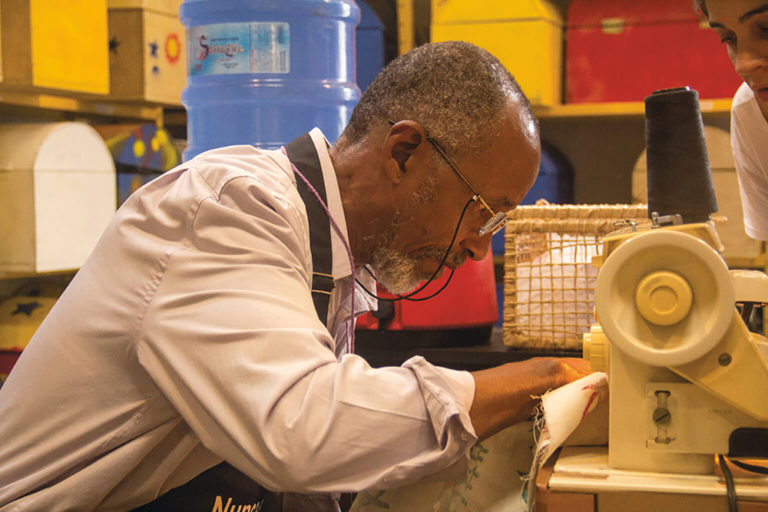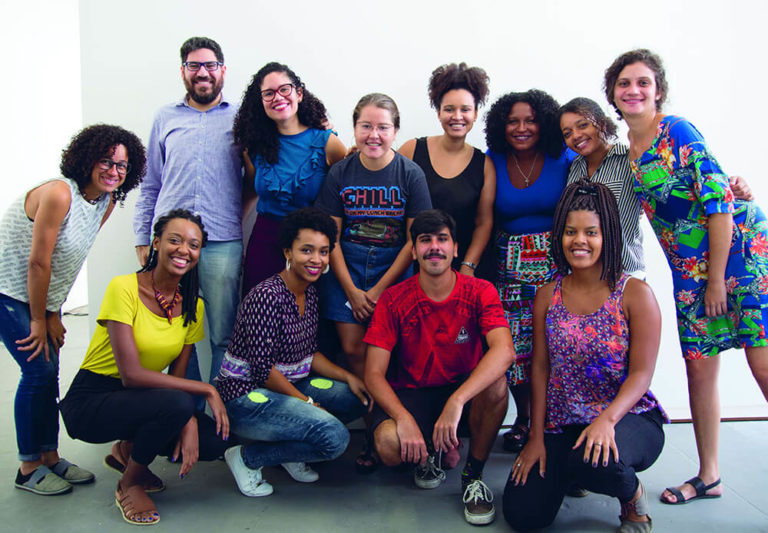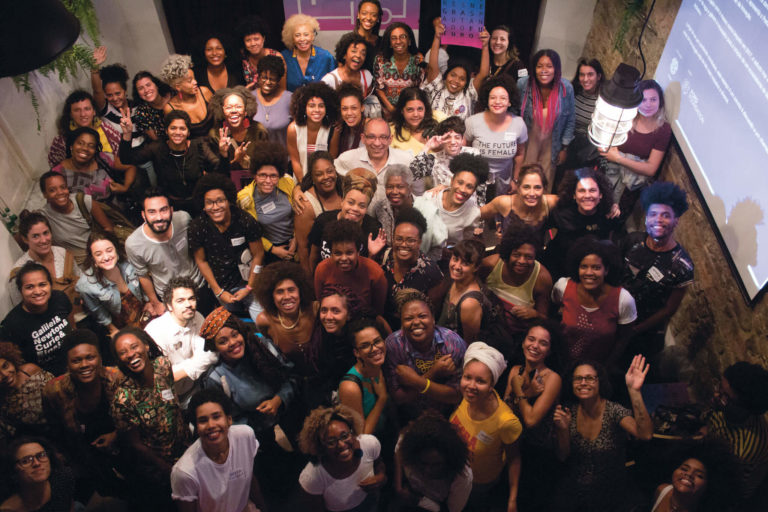EN PT/BR
For more diversity in Technology
Lately, I have been calling myself a curious person. And I think it’s curiosity that has led me to try new ideas. I am a journalist, a researcher, a teacher and I do a lot of other things. I recently co-directed the documentary Quadro negro [Blackboard] with Bruno F. Duarte for FLUP – Festa Literária das Periferias [Ghetto Literature Fest]. Quadro negro is a documentary about the stories of this generation of Black people who are the first from their families to go to university, which I am part of. I have never worked with audiovisual other than communication for films—but the idea is to put myself inside this little box of curiosity because I think it moves a lot.
Olabi, which is the organization that I co-direct alongside Gabi Agustini, is born as a makerspace—I don’t know if everyone is familiar with this concept, but in general terms it’s a place equipped with digital manufacturing machines, such as a 3D printer, laser cutter, and CNC machine (Computer Numerical Control). And we were—and still are—very interested in understanding what it means to be a maker in Brazil’s context. Because most of the bibliographies we have on this subject are from the Northern hemisphere, and we believe that Brazilians are makers par excellence. We are always creating solutions to real problems that are often not seen as solutions or innovations.
We were born in 2014 as an organization working within three axes: diversity, technology, and social innovation. As we are a young organization, every year we rethink ourselves and think about our mission’s focus, the democratization of technologies, which will guide our actions that year. Currently, we have been thinking within four axes: longevity, because the Brazilian population is getting older; science and technology, because that is what has been guiding many of our tastes and choices; and dialogue between areas of knowledge. As a matter of fact, nobody understands much of what Olabi does.
People always ask “Sil, what is Olabi?” and I say this is a social organization that works within these axes, but, interestingly, people don’t understand too well what we do because, in this way, we also manage to transit among several bubbles. This way, the very high-tech people think we are too much of a social movement to be a technology movement. The social movement people think we are too much technology to be a social movement, so we walk along the margins. On the edges.
I have brought some examples of projects that we have developed and have been developing, in recent times, within these axes that have guided our actions. That is the case of “60+ Arte e tecnologia” [60+ Art and Technology], which is a mixed techniques workshop project focused on people over 60. All of our work and methodologies are based on mixing knowledges and expertises.
Workshop “60+Arte e tecnologia” [60+ Art and Technology] at Maré, Rio de Janeiro. November, 2019.
Source: Monara Barreto / Olabi
We were thinking about how we could talk about technology and be able to dialogue with the citizen who is not inside this bubble by presenting things that make sense to them. So we have been creating courses that mix these knowledges since 2014. A few years ago we created the course “Costura high-tech” [High-Tech Sewing], with the idea of mixing embroidery, cutting and sewing knowledge, with 3D printing and open electronics, to build wearable technologies. We also developed the 60+, a project whose second edition recently took place in the Complexo de Favelas da Maré (Maré Favela Complex), at our partner’s venue data_base.
This project generated another one: Aprenda com uma avó [Learn with a Grandmother], a platform that we recently launched. We started with the idea that everyone has something to learn and to teach, so why can’t we dialogue with these other audiences too? We have a YouTube channel called Computação sem caô [Computing without Bullshit], which is a project inside a bigger umbrella to think about how we can work to make computing for everyone. Computação sem caô takes computer science concepts that are, in general, very complex, and transforms them into more accessible language. So there is, e.g., “How does Waze work?” The idea is to be in dialogue with people from different places and expertises, stimulating individuals from the whole of society to approach these concepts that are often restricted to certain bubbles.
All of this is part of a position of questioning rather than answering. We don’t have many answers to all this newness, but we are creating ideas and ways to bring more people to think about it. And the most important cause of these four axes that we have been working on is race. It’s complicated to talk about anything without thinking about the racial issue in Brazil. Because our country has a very recent history of slavery, it’s been only 132 years of “abolition.” We talk a lot about historical debt but it’s not a historical debt; it’s a current debt and we need to work to break this inequality. And this is not a Black people’s matter, this is a matter for society as a whole.
Fighting against racism is the strongest pillar in our actions today. When I met Maria Rita Casagrande, who is one of the most interesting and important developers I know, that’s when I had the idea of creating a project, so that I could see other Black women in these discussions. PretaLab was born in 2017. And I didn’t know very well what it would be. The initial idea was to gather Black women to discuss technology and innovation with them. Why? Why do we want to work this axis with this specific audience? Simply because in Brazil Black women represent more than 28% of the population, and that means a little over 60 million people. And we are accumulating the worst rates in several areas, from education and health to employment. We then decided to look for research that would raise the issue of gender and race in technology. We found data from the U.S. that says that only 4% of technology startups are run by Black women.
In Brazil, I was looking for data that would cover this intersection and I did not find anything made by a large research center. I found this one, which was made in 2013 by Poligen [the Gender Studies group at University of São Paulo’s Polytechnic School], in the year that USP completed 120 years, and which says that only ten Black women graduated in the university’s technology center. Well, I looked at this and asked myself what I was going to do with that. PretaLab’s first action was to create a very informal survey from our institutional networks—the idea was to map, to try to understand where in Brazil and in which area of technology these women were. Because when we talk about technology, what are we talking about, after all? It is also interesting to think that in this first mapping we wanted not only to map the engineers, the women in IT, but also the designers, the content producers, the women in audiovisual. So, for us, under this umbrella of technology, there is room for all these people. We wanted to look at that, and understand what they were doing.
In less than a year of surveying, we have reached almost 600 women. Obviously, we have not reached all women—we know there are many limitations—but we have reached women in more than twenty states of Brazil, in all regions, and with an enormous diversity of age and area. For example, we reached women from 17 to 67 years old. This survey also oriented our actions. In the same year, we made a series of videos with Black women who already have recognized work in the area because we wanted to stimulate this more subjective field of inspiration. One thing that I am always asked is why there’s so few Black women in this area. I believe the first thing is the lack of opportunity. We live in a very unequal country and the structural issue is very relevant. But there’s another thing —and why I loved Didiana Prata’s considerations—which is this image aspect: Because we don’t have this repertoire of images, we never imagine that we can be in certain places when we don’t see other people who look like us in those places.
Then, within these three years of the project we did a lot of things. We created methodologies, immersions, projects that worked with data, that focused on Black women such as Minas de dados [Data Girls], the result of a partnership with data_labe and Transparência Brasil, and that generated another project called Mulheres negras decidem [Black Women Decide], in which women participating in this formation created a project to evaluate the underrepresentation of Black women in institutional politics in Brazil. And the unfortunate coincidence is that the day they were defending this thesis to a jury, which was much inspired by the work of councilor Marielle Franco, was also the day Marielle was murdered.
Minas de dados [Data Girls]: immersive program for Black women on the use of data for initiatives directed for the common well-being. March, 2018.
Source: Safira Moreira / Olabi
We also organized the Mulheres negras pautando o futuro [Black Women Guiding the Future], a meeting to discuss knowledge, bringing different elements together. This was the first edition and we invited Sônia Guimarães, the first Black Physics professor at the Brazilian Aeronautics Institute of Technology; Jurema Werneck, director of Amnesty International; and Gabi Roza, a journalist from data_labe, to discuss a little about what technology has to do with human rights. In many places I arrive, when I say that I work with technology, people assume it’s about robots or that I’m a programmer, but in fact, my concern and research in technology is the impact that has on us as a society. And how much all this technology can also increase inequality.
Mulheres negras pautando o futuro [Black Women Guiding the Future]. July, 2018.
Source: Safira Moreira / Olabi
This year, 2019, we launched a new platform on the PretaLab website, “pretalab/perfis” [pretalab/profiles], which gathers profiles of Black women in technology. And then why did we do it? It’s a development of our 2017 research, but this platform has at least three objectives: one is that we get to know each other; the second is that we work and collaborate for the visibility of women’s work; the third is to give an answer to the labor market that says it does not find qualified Black women in this area. This is because, after we launched PretaLab, many companies and organizations asked us how to reach “Black talent.” It’s not just about getting Black people in your company, or your organization, but how you create anti-racist policies for those people to stay there. That is an attempt to be in dialogue a little more with the technology market.
In 2019 we launched a research project together with ThoughtWorks entitled: “Quem coda o Brasil? / Quem coda BR” [Who Codes Brazil? / Who Codes BR] in which we looked at technology companies’ technical teams to understand how diversity was included there. We already had an assumption, which was that there was no diversity. There is not even gender diversity, let alone gender and race, because, unfortunately, these sectors are still very concentrated in one standard type of people. But I think this is going to change because there are so many job positions available and the technology market is the one that grows the most, it’s the most promising in the whole world that at some point there will be no way it won’t absorb our labor.
Finally, I want to show a new initiative that we launched last year. We tried to understand codes from this idea of how we can create codes and languages for a anti-racist daily life. Thus Códigos negros [Black Codes], an event made in Olabi along with Plataforma Cabine and Plataforma Gente was created in November. Códigos negros’ proposition was to discuss over three axes: art, communication, and technology. A whole day of exchanges with people who are producing knowledge in these areas. For the first edition, we invited Murilo Araújo (journalist, researcher, an activist for the Black LGBT movement, and YouTuber), Isabel Aquino (publicist and communication strategist), and Renata Novaes (journalist and content director) to the panel “Gente” [People] to discuss languages of communication. For the panel “PretaLab” we invited Maria Rita Casagrande (full stack developer, mother, editor, content curator, technology and business innovation consultant), Tarcízio Silva (researcher and curator at Desvela, Ph.D. student at Humanities and Social Science at Federal University of ABC (UFABC, Brazil)), and me as a facilitator. And finally, to the panel “Cabine” [Cabin] we invited Yhuri Cruz (visual artist and writer), Jess Oliveira (translator, poet, literary critic and editor), and Bruno F. Duarte (creator of the Black LGBT art platform Cabine and master student in Communication and Culture at Federal University of Rio de Janeiro (UFRJ, Brazil)).
Códigos negros [Black Codes]: languages for an anti-racist day-to-day. November, 2019.
Source: Paulo Oliveira / Olabi
Códigos negros is an experiment that tries to find out what these codes are and how we can bring them to a reality that doesn’t remain inside the common bubbles only, because this is one of my biggest concerns: how do we tell this to other people?
I always say that I like the evangelical church methodology, which is to “spread the word.” How do we spread the word? Looking at the world, especially Brazil nowadays, I think one of the biggest social challenges we have is the lack of dialogue. We are in a world that seems surrounded by walls, so how do we create a bridge of dialogue between people? With different people, not only with Black people, not only with women but with the world. I’m very interested in this question because one topic we always discuss is: If the future is tech, how are we building this future? I don’t think the future is tech; I think the present is tech because the future we’re talking about all the time is being built now. How can we build a future where more people fit in? One thing that becomes very clear in the texts of this book is that technology is not neutral. It is not indeed. We should look at this world and see we have a lot of technology, but we still have a lot of social problems.
I really wanted technology to be also used to solve social problems. If this future is tech, I would like to have more diversity in technological production.



